Advertisements
Advertisements
प्रश्न
A vessel containing 50 kg of water is placed at a height 15 m above the ground. Assuming the gravitational potential energy at ground to be zero, what will be the gravitational potential energy of water in the vessel? (g = 10 m s-2)
उत्तर
Mass of water, m = 50 kg
Gravitational force F = mg = (50 × 10) N
Height, h = 15 m
Gravitational potential energy = mgh
= 50 × 10 × 15
= 7500 J
APPEARS IN
संबंधित प्रश्न
A force of 7 N acts on an object. The displacement is, say 8 m, in the direction of the force (see the given figure). Let us take it that the force acts on the object through the displacement. What is the work done in this case?

Why is a jack screw provided with a long arm?
State the S.I. unit of energy.
Define 1 joule of energy.
A force of 30 N acts on a body and moves it through a distance of 5 m in the direction of force. Calculate the work done by the force.
.A man raises a box of mass 50kg to a height of 2m in 20s, while another man raises the same box to the same height in 50s. Compare:
(i) the work done, and
(ii) the power developed by them.
The work done by a force acting obliquely is given by the formula : W = F cos θ ✕ s. What will happen to the work done if angle θ between the direction of force and motion of the body is increased gradually? Will it increase, decrease or remain constant.
A max X goes to the top of a building by a vertical spiral staircase. Another man Y of the same mass goes to the top of the same building by a slanting ladder. Which of the two does more work against gravity and why?
Nm is the unit of .......
A block of mass 20 kg is pulled up a slope (fig.12) with a constant speed by applying a force of 500 N parallel to the slope. A and B are initial and final positions of the block.
(a) Calculate the work done by the force in moving the block from A and B.
(b) Calculate the potential energy gained by the block.

A bullet is of mass 'm' g and is moving with a velocity 'v' m/s. Find the kinetic energy of the bullet when
(a) The mass is doubled,
(b) The velocity is tripled.
Give an example
Chemical energy changes to heat energy.
State the amount of work done by an object when it moves in a circular path for one complete rotation. Give a reason to justify your answer.
Name the material commonly used for the manufacturing of solar cells.
What should be the characteristic of a source of energy?
Look at the activity below. Reason out whether or not work is done in the light of your understanding of the term ‘work’.
An engine is pulling a train.
Force acting on a particle moving in a straight line varies with the velocity of the particle v as F = `K/v`, where K is a constant. The work done by this force in time t is
A body of mass 0.5 kg travels on straight line path with velocity v = (3x2 + 4) m/s. The net work done by the force during its displacement from x = 0 tox = 2 m is ______.
